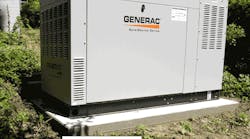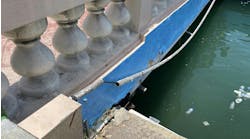How well do you know the Code? Think you can spot violations the original installer either ignored or couldn't identify? Here's your chance to moonlight as an electrical inspector and second-guess someone else's work from the safety of your living room or office. Brian, who has a knack for finding shoddy electrical work, did the dirty work and found this mess. Now it's your turn to identify the violation.
Find the Answer
Generally speaking, use of a single rod as the grounding electrode system for an optional standby generator is a violation, unless soil conditions are such that the rule in 250.56 can be satisfied. The wording of this rule is as follows: "A single electrode consisting of rod, pipe or plate that does not have a resistance to ground of 25 ohms or less shall be augmented by one additional electrode of any of the types specified by 250.52(A)(4) through (A)(8). Where multiple rod, pipe, or plate electrodes are installed to meet the requirements of this section, they shall not be less than 1.8 m (6 ft) apart."
For the most part, there are very few locations where a single rod, pipe, or plate electrode will result in a ground resistance reading of 25 ohms or less, as determined by a ground-resistance measurement test. As a result, where a rod, pipe, or plate electrode is used as the grounding electrode system, one additional electrode must be provided. The additional electrode may be a ground ring [250.52(A)(4)], another rod or pipe [250.52(A)(5)], another "listed grounding electrode" (e.g., a chemical ground rod) [250.52(A)(6)], a plate electrode [250.52(A)(7)], or "other local metal underground system or structure" (e.g., a well cistern) [250.52(A)(8)]. This additional electrode must be located at least 6 ft from the first ground rod.
This rule is a bit strange in that use of a single rod as the grounding electrode system for this generator would require the inspector to perform a ground-resistance measurement test. Presumably, the inspector will also require a copy of the test results, which verify a ground-resistance reading of 25 ohms or less. However, where an additional rod is provided, there is no need to conduct a ground-resistance measurement test. Therefore, the easiest way to ensure compliance with this rule is to simply install an additional rod at least 6 ft from the first — at the same time you're installing the first rod.
In addition, it’s worth noting that, as given in 250.53(D)(2), the rule of 250.56 also applies where a metal underground water pipe is the only electrode of those identified in 250.52(A)(1) through 250.52(A)(4) at a building or structure. Whenever you are using a rod, pipe, or plate electrode to supplement the water pipe, a ground-resistance measurement must be performed. Or, as noted above, you could simply install an additional rod, pipe, or plate, in which case no test is required.



